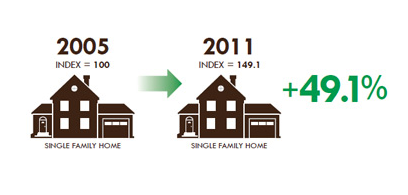The MLS® HPI is an alternative measure of real estate prices that provides a clearer picture of market trends over traditional tools such as mean or median average prices. It is a more stable price indicator than average prices because it tracks changes of ‘middle-of-the-range’ or ‘typical’ homes and excludes the extreme high-end and low-end properties.
 Typical homes are defined by the various quantitative property attributes (e.g. above ground living area in square feet) and qualitative housing features (e.g. proximity to shopping, schools, transportation, hospitals etc.) toward the home price of properties sold.
Typical homes are defined by the various quantitative property attributes (e.g. above ground living area in square feet) and qualitative housing features (e.g. proximity to shopping, schools, transportation, hospitals etc.) toward the home price of properties sold.
 Typical homes are defined by the various quantitative property attributes (e.g. above ground living area in square feet) and qualitative housing features (e.g. proximity to shopping, schools, transportation, hospitals etc.) toward the home price of properties sold.
Typical homes are defined by the various quantitative property attributes (e.g. above ground living area in square feet) and qualitative housing features (e.g. proximity to shopping, schools, transportation, hospitals etc.) toward the home price of properties sold.These features together become the ‘benchmark’ house, townhouse or apartment in a given area. A benchmark property is designed to represent a typical residential property in a particular MLS® HPI housing market, such as an individual community.
The breakdown of each month’s real estate sales in a given area are estimates of current prices paid for bedrooms, bathrooms, fireplaces, etc. Prices for these qualitative and quantitative features are then applied to the typical house model and an index price is estimated for that month.
In summary, the MLS® HPI measures the rate at which housing prices change over time taking into account the type of homes sold.